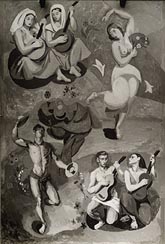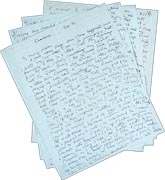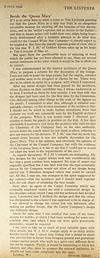|
Painting together |
House decoration |
The Hogarth Press |
Stage designs |
Berwick Church decorations
Borough Polytechnic murals |
The Cunard affair
The Cunard affair

In 1935 Cunard White Star Ltd. invited Grant and Bell along with other artists, to submit designs for decorations for the new flagship liner RMS Queen Mary.
Grant was commissioned to paint three panels for a lounge and Bell a small panel for a private sitting room next to the chapel.
The artists were also invited to suggest colour schemes for the rooms and designs for the carpets and soft furnishings.
Duncan received a visit from Benjamin Morris the American architect of the main public rooms, and Mr Leach who worked for the contractors.
Both men approved Duncan's initial designs and a contract was agreed, which offered exceptionally good terms to the artist.
Work was to be completed by 30 November 1935 and he would be paid £1200 for the three panels, a huge sum which, as Duncan gleefully commented in a letter to Vanessa
would make him 'colossally rich'.
Duncan and Vanessa spent the summer in Rome, Grant using the time to concentrate on half size studies of his panels: Seguidilla (a Spanish dance) and two paintings
of female figures, The Flower Gatherers and The Sheaf.
On returning to England however, he found out that the English architect overseeing the Queen Mary decoration had cancelled his carpet designs, and on writing to Mr Leach for
an explanation discovered furthermore that the Director had asked for the size of the panels, and the scale of the large female figures, to be reduced. |

Seguidilla, one of Duncan Grant's panels for the RMS Queen Mary
Courtesy of Agnew's |

Letter from Vanessa Bell
to Julian Bell
© Henrietta Garnett.
All rights reserved |
Grant, deeply upset, replied to Leach pointing out that the designs had been submitted for approval more than three months previously.
He went on to say:
| I consider it rather late in the day to criticize my choice of subject...
I have been working since the end of May on my designs, given up all other work, and put myself at considerable expense in consequence. |

Duncan Grant to Mr Leach, 21 September, 1935,
as quoted in Francis Spalding's biography of Duncan Grant |
On receiving Duncan's letter, Leach and the architect visited his studio and the outcome was that Duncan agreed to modify the size of his figures, and Vanessa and Duncan
were invited to visit Liverpool to see work in progress on the Queen Mary.
In this letter to her son Julian, Vanessa describes the Liverpool visit which included an expensive meal courtesy of Cunard. Vanessa, whose panel for the chapel had also been
rejected as inappropriate, was invited to create another panel for the private dining room. |
In February 1936, Duncan's panels were completed and installed, and, incredibly at this late stage, rejected again by Cunard's Chairman Sir Percy Bates as ill-suited to the
purpose of the room and the type of fashionable clientele he hoped to attract: royalty, film stars, and business magnates.
Although he received payment for the panels, Grant, dumbfounded, demanded their return and compensation for damage to his reputation.
Cunard refused his demands but did not reckon on Grant's following or his powerful and loyal friends who immediately leapt to his defence.
Letters of protest arrived at Cunard from such important figures as Directors and Trustees of the Tate, the National Gallery and the V&A.
The 'unholy row', as Vanessa Bell described it to her son Julian, even reached royalty as Kenneth Clark, Director of the National Gallery and a supporter of Grant was on good
terms with the King and promised to rouse His Majesty's interest in the debate.
Clive Bell wrote an article in The Listener, 8 April 1936 criticizing the Company and ridiculing the 'frivolous and frightened attitude to art of rich people who are not
sure of themselves'.
Duncan himself wrote a letter which was also published in The Listener, telling his side of the story.
The widespread press coverage frightened Cunard into returning the panels and paying compensation to the artist.
The panels were exhibited at Agnew's and Sons Gallery in 1937, and were very well received.
| They are superb decorations and it seems a great pity not to use them.
It is doubtful whether anyone else in Britain could have made paintings so vital in line and breathtaking in colour.
By showing them Grant vindicates himself entirel. |

The Scotsman, 12 Nov, 1937 |
However, despite the support and positive reception of the paintings when they were exhibited, Grant's reputation never fully recovered after the publicity surrounding the
Cunard affair. |

The Listener
'Inside the
Queen Mary'
© The Listener |
|
